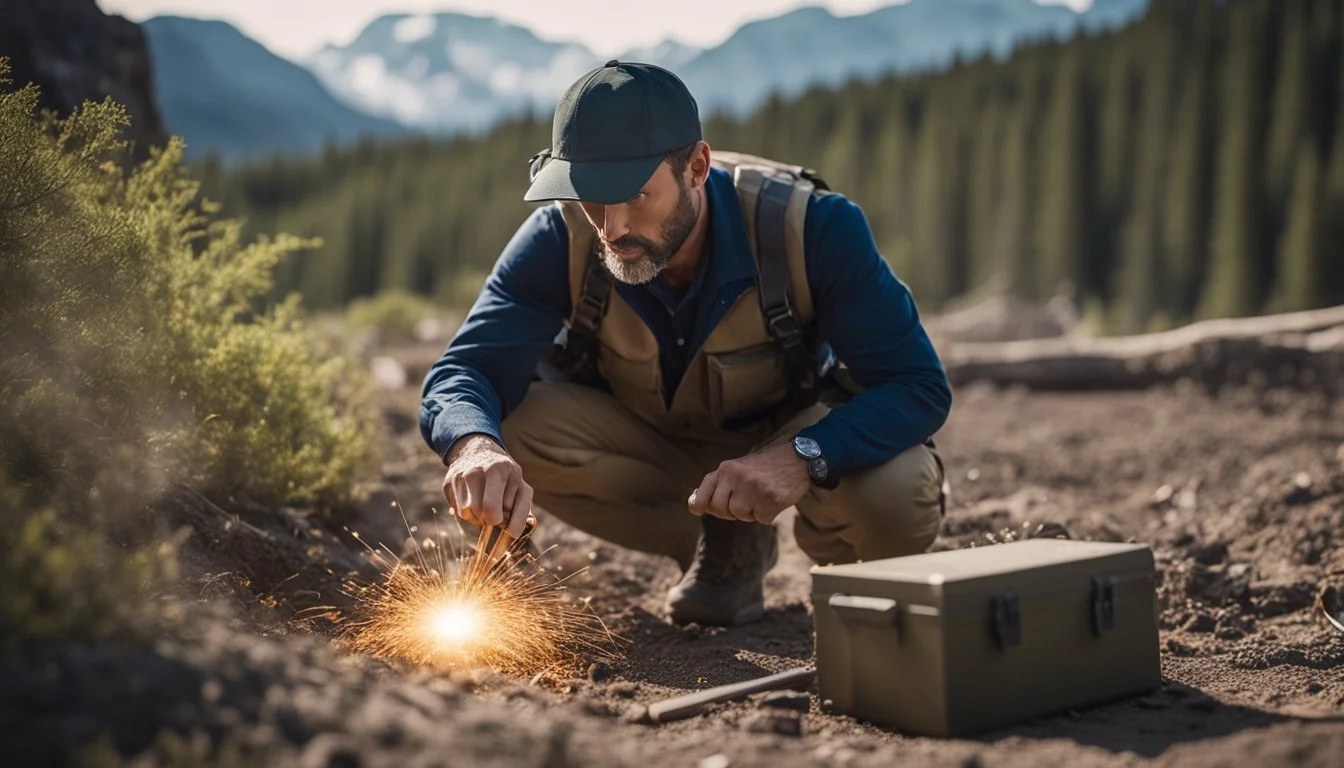5 Dynamite Dick Clifton Documentaries: The Explosives Expert
Unveiling a Demolition Legend's Career
Dynamite Dick Clifton, a member of the infamous Doolin Gang, left an indelible mark on the American Old West. His life of crime and notorious exploits have captivated historians and filmmakers alike, leading to the creation of several documentaries that explore his intriguing story.
These documentaries offer viewers a chance to delve into the world of this enigmatic outlaw, shedding light on his role in the Doolin Gang's bank robberies and his eventual demise at the hands of law enforcement. From his early days as a minor criminal to his rise as a feared outlaw, Clifton's life provides a fascinating glimpse into the lawless frontier of late 19th-century America.
1) Explosive Legends: The Story of Dynamite Dick Clifton (2018)
This documentary explores the life of Charles Daniel "Dynamite Dick" Clifton, a notorious outlaw of the American Old West. Born in 1865, Clifton gained infamy as a member of the Doolin Gang in the 1890s.
The film delves into Clifton's criminal career, which began with robbery, safecracking, and cattle rustling in Oklahoma Territory. It examines his eventual partnership with Bill Doolin and participation in the gang's daring bank robberies.
Viewers learn about the origins of Clifton's explosive nickname. One theory suggests he lost fingers in a childhood dynamite accident, while another claims he was injured during a train safe-cracking attempt.
The documentary covers Clifton's capture and imprisonment in 1896, as well as his subsequent escape with Bill Doolin. It concludes with the events leading to his death on December 4, 1896, while on the run from law enforcement.
Through interviews with historians and archival footage, this film paints a vivid picture of Dynamite Dick Clifton's brief but eventful life as an Old West outlaw.
More information on Dynamite Dick Clifton
2) The Impact of Dynamite: Dick Clifton's Revolutionary Techniques
Dick Clifton's expertise with explosives earned him the nickname "Dynamite Dick" and revolutionized criminal operations in the late 19th century. His innovative use of dynamite for safe-cracking and robbery made him a valuable asset to outlaw gangs.
Clifton's techniques allowed gangs to access secure areas and valuables more efficiently than traditional methods. His skills were particularly useful for bank heists and train robberies, enabling quicker access to safes and vaults.
The use of explosives in criminal activities posed new challenges for law enforcement. Officers had to develop countermeasures and adapt their tactics to deal with the increased destructive power at outlaws' disposal.
Clifton's expertise extended beyond mere demolition. He demonstrated a nuanced understanding of explosive properties, allowing for more controlled and targeted applications in various criminal scenarios.
His methods influenced other outlaws, who sought to replicate his success. This led to a rise in explosives-related crimes across the American West, prompting authorities to tighten regulations on dynamite and other explosive materials.
3) Dangerous Brilliance: The Life and Times of Dynamite Dick Clifton
Charles Daniel "Dynamite Dick" Clifton led a life of crime in the American Old West during the late 19th century. Born around 1865, Clifton gained notoriety as a skilled safecracker and explosives expert.
Before joining the infamous Doolin Gang in 1892, Clifton was already a wanted man in Oklahoma Territory. His criminal resume included robbery, safecracking, and cattle rustling.
As a member of the Doolin Gang, Clifton participated in several bank robberies between 1892 and 1893. His expertise with explosives proved valuable during these heists.
Two stories explain Clifton's nickname "Dynamite Dick." One claims he lost three fingers in a childhood accident with dynamite. The other suggests he was blown out of a train car while attempting to crack a safe.
Clifton's criminal career came to an end on November 7, 1897, near Checotah in Indian Territory (now Oklahoma). His life of danger and notoriety made him a legendary figure in Old West outlaw lore.
4) The Art of Explosives: Dick Clifton's Innovations
Charles Daniel "Dynamite Dick" Clifton gained notoriety for his skill with explosives in the late 19th century. As a member of the Doolin Gang, he applied his expertise to safecracking during bank robberies.
Clifton refined techniques for using dynamite to blast open safes quickly and efficiently. He developed methods to shape explosive charges for maximum effect while minimizing collateral damage to surrounding structures.
His innovations allowed the gang to access vault contents swiftly before law enforcement could respond. Clifton's precision with explosives earned him respect among fellow outlaws and fear from lawmen.
While details of his specific techniques remain unclear, Clifton's reputation suggests he possessed an advanced understanding of explosives for his era. His skills contributed significantly to the Doolin Gang's success in their criminal enterprises.
5) Outlaw and Explosives Expert: The Duality of Dick Clifton
Daniel "Dynamite Dick" Clifton led a double life as both an outlaw and explosives expert in the late 19th century American West. His criminal activities included robbery, safecracking, and cattle rustling in Oklahoma Territory.
Clifton gained notoriety after joining the infamous Doolin Gang in 1892. He participated in several bank robberies with the group, showcasing his skills as a seasoned criminal.
The origin of Clifton's "Dynamite Dick" nickname remains uncertain. One story suggests he acquired it after a childhood accident with explosives that cost him three fingers. This incident may have sparked his interest in demolitions.
Clifton's expertise with explosives made him a valuable asset to the Doolin Gang. His knowledge likely proved useful during their bank heists and other criminal endeavors.
In June 1896, lawmen captured Clifton and imprisoned him in Guthrie, Oklahoma. He escaped a month later but was eventually tracked down and killed near Checotah, Oklahoma in November 1897.
Historical Background
Charles Daniel "Dynamite Dick" Clifton gained notoriety as an outlaw in the American Old West during the late 19th century. His life was marked by criminal activities and a reputation for using explosives.
Early Life of Dynamite Dick Clifton
Born in 1865, Clifton grew up in the tumultuous post-Civil War era. He turned to crime at a young age, engaging in robbery, safecracking, and cattle rustling in Oklahoma Territory.
His criminal pursuits eventually led him to join the infamous Doolin Gang in 1892. This association elevated his status in the outlaw world and expanded his criminal activities.
Clifton's nickname "Dynamite Dick" originated from his expertise with explosives. He used this skill during bank robberies and other criminal exploits, cementing his reputation as a dangerous and resourceful outlaw.
Role in Early Explosives Development
While not an inventor or legitimate developer of explosives, Clifton played a notable role in the illicit use of dynamite for criminal purposes. His proficiency with explosives set him apart from other outlaws of his time.
Clifton's exploits coincided with the increasing availability and use of dynamite in the late 19th century. Originally invented by Alfred Nobel in 1867, dynamite quickly found both legitimate and criminal applications.
In the hands of outlaws like Clifton, dynamite became a powerful tool for safe-cracking and creating diversions during robberies. His use of explosives in criminal activities highlighted the dual nature of this technological advancement.
Major Contributions to Explosives Technology
Dick Clifton made significant advancements in explosives technology during his career. His innovations improved safety and efficiency in mining and construction applications, while also setting new industry standards for explosive formulations and detonation methods.
Innovations and Inventions
Clifton developed a more stable form of dynamite by adding diatomaceous earth as an absorbent. This reduced the risk of accidental detonation during transport and handling. He also created a waterproof blasting cap that allowed for more reliable underwater explosions.
Clifton invented a remote detonation system using electrical currents, enabling safer ignition from a distance. This technology became widely adopted in mining operations. His work on shaped charges helped focus explosive energy more precisely, increasing effectiveness while using less material.
Impact on Industry Standards
Clifton's innovations led to new safety protocols in explosives manufacturing and usage. His improved dynamite formulation became the industry benchmark, requiring companies to meet higher stability standards. Mining and construction firms adopted his remote detonation methods as best practices.
His research on explosive velocity and pressure waves contributed to more accurate blast modeling. This allowed for better prediction and control of explosions in various applications. Clifton's work also influenced regulations on explosives storage and transportation, enhancing public safety.
Controversies and Challenges
Dynamite Dick Clifton's explosive expertise brought scrutiny and debate. His methods and activities raised concerns about safety and legal implications.
Safety Concerns and Incidents
Clifton's use of explosives posed significant risks. Several incidents were attributed to his handiwork, including a failed bank robbery in 1893 where a premature detonation injured bystanders.
In 1894, an explosion at a train station linked to Clifton caused property damage but no casualties. These events highlighted the dangers of his techniques.
Law enforcement struggled to prevent Clifton's attacks due to his unpredictable methods and skill in handling volatile materials.
Legal and Ethical Issues
Clifton's activities sparked debates about the regulation of explosives. His ability to acquire and use dangerous materials exposed weaknesses in existing laws.
Critics argued that stricter controls were needed to prevent criminals from obtaining explosives. Supporters of tighter regulations cited Clifton's case as evidence of the potential for misuse.
The ethical implications of Clifton's expertise were also questioned. Some viewed his skills as a dangerous form of knowledge that should be restricted, while others saw it as neutral technical ability.
Legacy and Recognition
Dan Clifton's exploits as "Dynamite Dick" left a lasting mark on Old West history. His reputation as an explosives expert and outlaw continues to fascinate historians and pop culture enthusiasts alike.
Awards and Honors
No formal awards or honors were bestowed upon Dan Clifton during his lifetime or posthumously. As an outlaw, his actions were outside the law and not officially recognized. However, Clifton's notoriety has earned him a place in Western folklore and historical accounts of the Doolin Gang.
His skills with explosives and daring exploits have been documented in various books and articles about Old West outlaws. Some museums and historical societies in Oklahoma feature exhibits or information about Clifton as part of their coverage of the Doolin Gang's activities in the region.
Influence on Future Generations
Clifton's legacy as "Dynamite Dick" has influenced depictions of outlaws in popular culture. His expertise with explosives has been referenced in Western novels, films, and television shows featuring characters skilled in safe-cracking or demolitions.
The nickname "Dynamite Dick" has become synonymous with skilled explosives handlers in outlaw narratives. Clifton's life story has inspired writers and filmmakers exploring themes of frontier justice and outlaw life in the American West.
His association with the Doolin Gang has contributed to the larger mythos surrounding outlaw gangs of the era. Clifton's exploits continue to be studied by historians researching law enforcement techniques and criminal activities in the late 19th century Oklahoma Territory.










